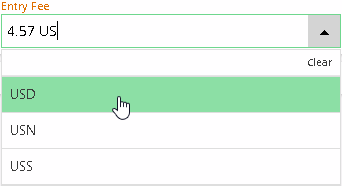Currency/Measure¶
This document is still under construction. The completed version will be available in IFS Applications 10 Update 6.* *
The Currency/measure client control shows a combination of a value and a unit. For example, the value "5" has no context without the unit "$". When grouping the value and unit into a combination, it also saves space, and ensures that both are shown with one another.

Figure 1 - Currency/Measure control with value and unit as one combination.

Figure 2 - Currency/Measure control (read-only mode).

Figure 3 - Currency/Measure control (edit mode).
Variations¶
Currency/Measure can be added either as a currency or a measure control. The functionality is the same regardless if it is added to use currency or measure, but it is recommended to only use currency when the unit is a currency, and measure for other value/unit combinations.
When to use¶
Use a Currency/Measure client control to show a value and unit as one combination. When a value and unit are combined, it is still possible to change each of them individually, or make only one of them editable.
In IFS Cloud there is also a basic data setup for both Currency Codes and Unit of Measure. When these data setups are applied, it ensures that only valid currencies and unit of measures are used.
Currency/Measure can be placed in groups, lists, selectors and cards.
How to use¶
The steps below describes how to add a currency/measure client control to a page:
Defining the entity file¶
- Define the two attributes in the.entity file. One attribute for the value, and one for the unit.
attributes {
...
public EntryFee NUMBER A-IU-;
public CurrencyCode TEXT(3)/UPPERCASE A-IU-;
}
Defining the projection file¶
- If necessary, define the entityset to use a lookup in the.projection file.
entityset IsoCurrencyEntitySet for IsoCurrency;
entityset IsoUnitSet for IsoUnit;
Defining the client file¶
- Define the currency code in the.client file.
currency EntryFee(CurrencyCode) {
unitlookup IsoCurrencyEntitySet(CurrencyCode);
unitselector IsoCurrencySelector;
}
selector IsoCurrencySelector for IsoCurrency {
static CurrencyCode;
}
Setting the appropriate properties to the currency/measure client control¶
The unit can be set to read-only, which makes it possible to only change the value on the field, but not the currency/measure unit.
NOTE! It is not necessary to define the property unitlookup when the unit is read-only.
- Set the property to be not editable in the.projection file or in the.client file.
uniteditable = [false];
currency EntryFee(CurrencyCode) {
uniteditable = [false];
}
*Example code - The property uniteditable is set to false in the client file*
- Hide the unit, for example if the value is
null.
currency EntryFee(CurrencyCode) {
unitvisible = [EntryFee != null];
uniteditable = [false];
}
Example code - The property unitvisible is set to hide the unit
- Set the unit to only be editable during creation of a record.
uniteditable = [IsNew];
Add Currency/Measure to a container¶
- Add the Currency/Measure control to the same places as for any other field (inside a Group, List, Selector, or Card.
list <list_name> {
...
currency <data_item_name>(CurrencyitemRef) {
...
}
measure <data_item_name>(MeasureitemRef) {
...
}
}
Limitations¶
None.
Properties¶
Below is a list of properties that can be used to customize the control.
columnexclude | columnvisible | editable | format | label | preserveprecision | required | searchable | showlabel | size | uniteditable | unitexportlabel | unitlookup | unitrequired | unitselector | unitvisible | validate command | visible
Example¶
[Comment]: Is it possible to have a new example with screenshot here? Similar to Figure 1, but also with a complete code example. Perhaps an example that is not about currency?
Below is an example of how currency/measure is used to represent....
Screenshot of example here
Figure 4 - Currency/measure example
// Example code for currency/measure
..